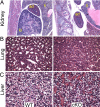In vivo functions of the proprotein convertase PC5/6 during mouse development: Gdf11 is a likely substrate
- PMID: 18378898
- PMCID: PMC2299217
- DOI: 10.1073/pnas.0709428105
In vivo functions of the proprotein convertase PC5/6 during mouse development: Gdf11 is a likely substrate
Abstract
The proprotein convertase PC5/6 cleaves protein precursors after basic amino acids and is essential for implantation in CD1/129/Sv/C57BL/6 mixed-background mice. Conditional inactivation of Pcsk5 in the epiblast but not in the extraembryonic tissue bypassed early embryonic lethality but resulted in death at birth. PC5/6-deficient embryos exhibited Gdf11-related phenotypes such as altered anteroposterior patterning with extra vertebrae and lack of tail and kidney agenesis. They also exhibited Gdf11-independent phenotypes, such as a smaller size, multiple hemorrhages, collapsed alveoli, and retarded ossification. In situ hybridization revealed overlapping PC5/6 and Gdf11 mRNA expression patterns. In vitro and ex vivo analyses showed that the selectivity of PC5/6 for Gdf11 essentially resides in the presence of a P1' Asn in the RSRR downward arrowN cleavage motif. This work identifies Gdf11 as a likely in vivo specific substrate of PC5/6 and opens the way to the identification of other key substrates of this convertase.
Conflict of interest statement
The authors declare no conflict of interest.
Figures






Similar articles
-
PCSK5 and GDF11 expression in the hindgut region of mouse embryos with anorectal malformations.Eur J Pediatr Surg. 2011 Aug;21(4):238-41. doi: 10.1055/s-0031-1273691. Epub 2011 Apr 8. Eur J Pediatr Surg. 2011. PMID: 21480163
-
Osteopontin as a novel substrate for the proprotein convertase 5/6 (PCSK5) in bone.Bone. 2018 Feb;107:45-55. doi: 10.1016/j.bone.2017.11.002. Epub 2017 Nov 7. Bone. 2018. PMID: 29126984
-
Deletion of the gene encoding proprotein convertase 5/6 causes early embryonic lethality in the mouse.Mol Cell Biol. 2006 Jan;26(1):354-61. doi: 10.1128/MCB.26.1.354-361.2006. Mol Cell Biol. 2006. PMID: 16354705 Free PMC article.
-
Knock-out mouse models of proprotein convertases: unique functions or redundancy?Front Biosci. 2008 May 1;13:4960-71. doi: 10.2741/3055. Front Biosci. 2008. PMID: 18508561 Review.
-
Similar sequences but dissimilar biological functions of GDF11 and myostatin.Exp Mol Med. 2020 Oct;52(10):1673-1693. doi: 10.1038/s12276-020-00516-4. Epub 2020 Oct 19. Exp Mol Med. 2020. PMID: 33077875 Free PMC article. Review.
Cited by
-
HIV-induced neuroinflammation: impact of PAR1 and PAR2 processing by Furin.Cell Death Differ. 2019 Oct;26(10):1942-1954. doi: 10.1038/s41418-018-0264-7. Epub 2019 Jan 25. Cell Death Differ. 2019. PMID: 30683917 Free PMC article.
-
A GDF11/myostatin inhibitor, GDF11 propeptide-Fc, increases skeletal muscle mass and improves muscle strength in dystrophic mdx mice.Skelet Muscle. 2019 May 27;9(1):16. doi: 10.1186/s13395-019-0197-y. Skelet Muscle. 2019. PMID: 31133057 Free PMC article.
-
Site-specific cleavage of BMP4 by furin, PC6, and PC7.J Biol Chem. 2009 Oct 2;284(40):27157-66. doi: 10.1074/jbc.M109.028506. Epub 2009 Aug 3. J Biol Chem. 2009. PMID: 19651771 Free PMC article.
-
Thrombin activation of protein C requires prior processing by a liver proprotein convertase.J Biol Chem. 2017 Jun 23;292(25):10564-10573. doi: 10.1074/jbc.M116.770040. Epub 2017 May 3. J Biol Chem. 2017. PMID: 28468828 Free PMC article.
-
Molecular Evolution of the H5 and H7 Highly Pathogenic Avian Influenza Virus Haemagglutinin Cleavage Site Motif.Rev Med Virol. 2025 Jan;35(1):e70012. doi: 10.1002/rmv.70012. Rev Med Virol. 2025. PMID: 39730318 Free PMC article. Review.
References
-
- Steiner DF. The proprotein convertases. Curr Opin Chem Biol. 1998;2:31–39. - PubMed
-
- Seidah NG, Chretien M. Proprotein and prohormone convertases: A family of subtilases generating diverse bioactive polypeptides. Brain Res. 1999;848:45–62. - PubMed
-
- Seidah NG, Prat A. The proprotein convertases are potential targets in the treatment of dyslipidemia. J Mol Med. 2007;85:685–696. - PubMed
-
- Seidah NG, Day R, Marcinkiewicz M, Chretien M. Precursor convertases: An evolutionary ancient, cell-specific, combinatorial mechanism yielding diverse bioactive peptides and proteins. Ann NY Acad Sci. 1998;839:9–24. - PubMed
Publication types
MeSH terms
Substances
LinkOut - more resources
Full Text Sources
Molecular Biology Databases

